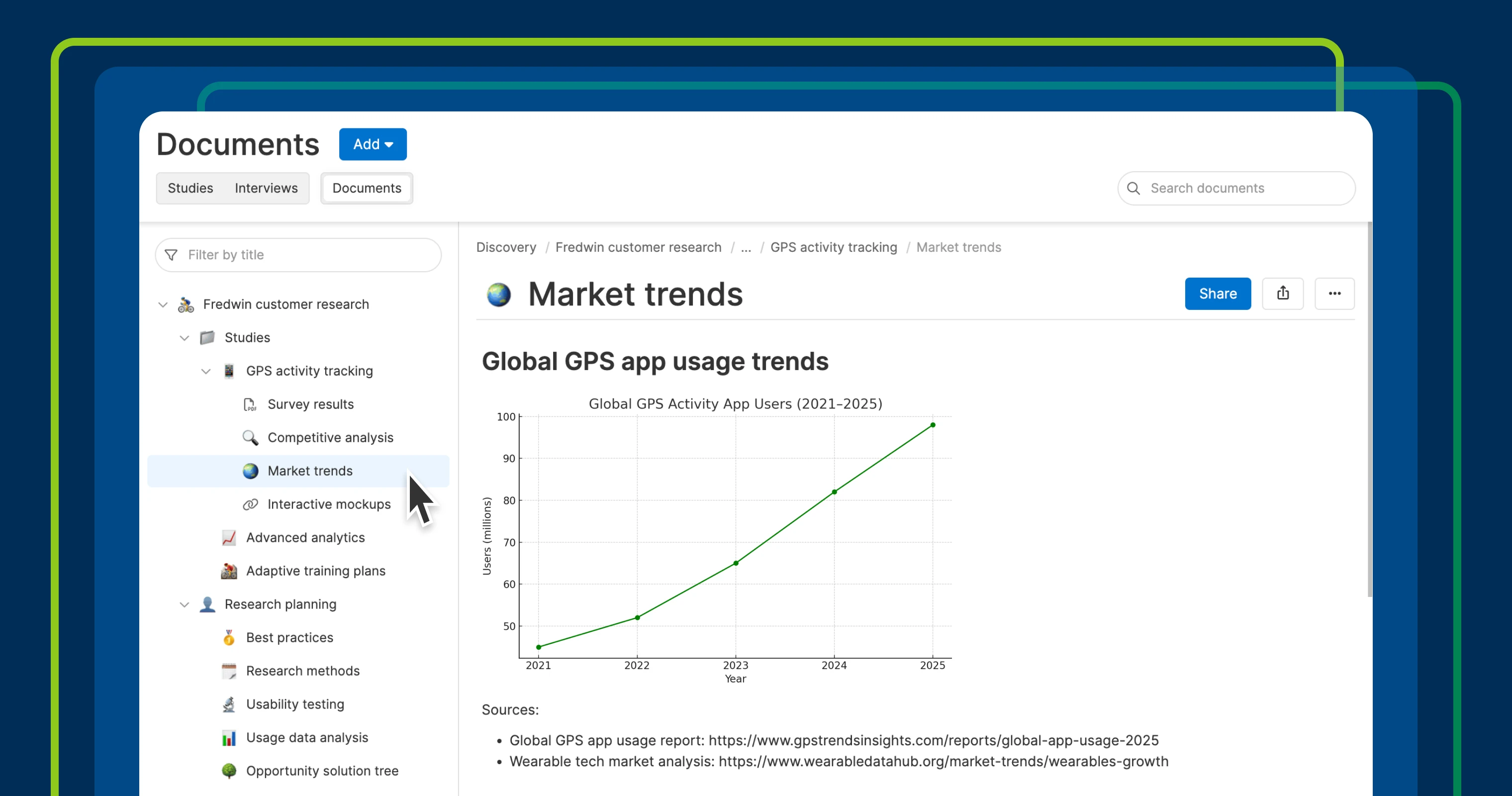
Customer interviews vs. customer feedback in product discovery
The adventurer and the academic. You know these character archetypes — one is a swashbuckling explorer in search of a hidden treasure, the other is their more bookish counterpart poring over historic texts for clues. (Sometimes, it is even two sides of the same character. Think: Indiana Jones.) But as different as they are, it always takes both to succeed.
To uncover the truth, you need the courage to seek what answers are out there and the ability to decipher what is already known.
Some of the best product insight comes straight from the people who use it. That is the foundation of product discovery: the process of uncovering new problems to solve and opportunities to innovate.
To find these insights, product teams do customer research. Let's focus on two types:
Customer interviews: Structured conversations with current or potential users (often done as part of research studies)
Customer feedback: Input from users collected through channels like ideas portals, support tickets, and user reviews
The two naturally intersect. As you organize and review feedback (a practice we call idea management), patterns can emerge that point to a larger question or unmet need. A recurring request might prompt a round of interviews. A set of frustrated comments could lead to usability conversations.
This is a common path, but it also underscores a deeper truth:
Customer interviews require deliberate effort. Feedback can arrive whether you ask for it or not.
Of course, you can seek feedback proactively through customer satisfaction polls or targeted surveys. But interviews still ask more of you. You have to find the right customers, plan conversations, and draw meaning from what is said.
Both are essential to discovery and ideation efforts. Feedback helps you stay grounded in what users are experiencing now. Interviewing customers helps you dig into what is missing and imagine what could be better. The best teams make room for both.
Reacting to feedback is important. But real product insight takes inquiry — not just intake.
We have been working to reinvest in this side of customer research on our own team (we even launched a new product discovery tool to help). If you are doing the same, understanding how managing user interviews compares to collecting feedback is a good place to start.
So let's dive in:
Tasks: How to manage customer interviews vs. feedback collection
Teams: Who leads customer interviews vs. who collects customer feedback
Timing: When to interview vs. when to collect customer feedback
How to implement insights from customer interviews vs. customer feedback
Best tools for managing customer interviews vs. collecting customer feedback
⭐️ Why customer interviews and customer feedback matter
Customer interviews surface unmet needs and help you validate new product ideas. They expose users' goals, pain points, and behaviors through open-ended questions.
Customer feedback reveals how users currently feel about your product. It gives you a steady stream of input — even when you are not actively seeking it.
Both fuel the product discovery process and help you understand the voice of the customer.
✅ Tasks: How to manage customer interviews vs. feedback collection
Customer research is ongoing, which makes it tough to simplify these methods into a few brief steps. But it is possible to take a general view. Managing customer interviews typically includes:
Planning research studies
Recruiting participants
Scheduling and leading customer interviews
Analyzing research findings
Customer feedback collection typically includes:
Setting up channels to gather customer input (e.g., in-app surveys, ideas portals)
Reviewing support tickets, community forums, and sales conversations
Organizing feedback and responding to customer-submitted ideas
What happens next — using what you learn to shape your product plans — is key.
👥 Teams: Who leads customer interviews vs. who collects customer feedback
At many organizations, product managers lead customer interviews with support from UX designers and researchers. They work together to uncover insights and translate them into product direction.
Feedback comes from multiple sources. Customers submit ideas directly. PMs gather insights from support tickets and sales conversations. Customer success and other frontline teams often help share input, too. It is the product manager's job to evaluate and act on what matters most.
📅 Timing: When to interview vs. when to collect customer feedback
Discovery interviews typically kick off earlier — when you are exploring what to build. Other types of customer conversations (like usability and validation interviews) might happen later in product development. But the best teams have these interviews continuously throughout the product lifecycle.
Feedback tends to emerge after people use the product. But just like interviews, this should not be confined to a single phase. Customer ideas roll in all the time, and each submission deserves a thoughtful review.
💡 How to implement insights from customer interviews vs. customer feedback
This is the whole point — turning insight into action.
Customer interview insights can lead in many directions. What you do will depend on what you learn. You might:
Identify new high-value ideas to add to the roadmap.
Adjust existing plans and priorities to better meet customer needs.
Fuel further research into new challenges you uncovered.
Customer feedback often follows a more defined path. When you have enough input, you can:
Identify patterns and themes.
Prioritize ideas based on value or strategy.
Promote ideas to features, then add them to your backlog or roadmap.
⚙️ Best tools for managing customer interviews vs. collecting customer feedback
Product discovery tools can help you manage customer interviews and make sense of what you learn. For example, Aha! Discovery gives you a central place to build a participant database, set up research studies, summarize interview insights, and link them directly to your roadmap.
Tools for collecting customer feedback (like idea management software) help you gather and organize user input. For example, Aha! Ideas lets you rank ideas, group them by theme, and explore the revenue potential — then promote the most valuable ones to your roadmap.
Choose tools for managing interviews and collecting feedback that support how your team works. This ensures both processes feel like seamless parts of your product discovery workflow.
If you want to rely less on assumptions and build with confidence, the answers are waiting for you. You just have to ask and listen.
Product discovery matters deeply to bringing the voice of the customer into your decisions. It is not easy to ask hard questions and manage the flow of feedback. But the extra effort you spend here will always be worth it.
Start a free trial
You can manage customer interviews and gather feedback in Aha! software. Our suite of tools includes Aha! Roadmaps, Aha! Discovery, Aha! Ideas, Aha! Whiteboards, Aha! Knowledge, Aha! Teamwork, and Aha! Develop. Use each product individually or combined to help teams deliver even greater value. Sign up for a free 30-day trial or join a live demo to see why more than 1 million product builders trust our software to build lovable products and be happy doing it.




